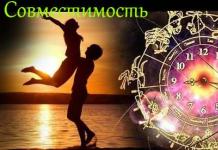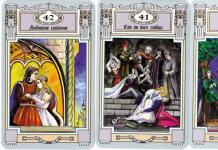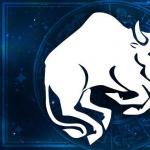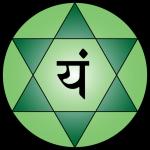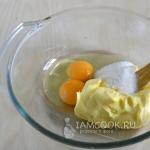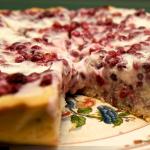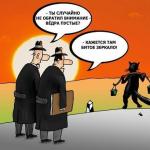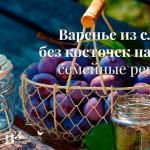Scandinavia is the northern territory of Europe, located on the peninsula of the same name and adjacent islands. In pre-Christian times, paganism flourished here and special magical symbols called runes were widely used. Miraculous signs were used in all spheres of life of the northern peoples. Runic symbols were placed by warriors on their armor and weapons, ordinary people wore amulets and amulets with signs inscribed on them, and used them to protect their homes as a guarantee of well-being. Each symbol, amulet and amulet has a specific meaning.
IT IS IMPORTANT TO KNOW! Fortune teller Baba Nina:“There will always be plenty of money if you put it under your pillow...” Read more >>
Runic signs of Scandinavia
The exact origin of runes is unknown; many scientists consider them to be the origins of language and painting - over the past millennia, the symbols have absorbed the energy of religion and the wisdom of ancient priests and warriors. The effectiveness of runic magic is ensured by the confidence of the practicing sorcerer in the final result.

- 1. Symbols of the Scandinavian gods - they became known thanks to military campaigns and trade relations in the Viking Age (VIII-IX centuries). It was then that Scandinavian signs spread across Europe all the way to the northern territories of Africa, America and the Slavic lands in the east. They are also called symbols of the Scandinavian Vikings. This is Valknut - the sign of Odin, who knows the ways of the dead; Mjolnir is Thor’s hammer, which has protective and protective functions; The golden necklace of the goddess Freya is the apotheosis of inaccessibility and unscrupulousness.
- 2. Everyday Scandinavian symbols - these include the Odal rune, which was often branded on boundary stones that determined the division of territories. The main meaning is spiritual and material continuity. Used for marking in order to preserve human values, symbolizes the fatherland, home, property, clan, family and traditions.
- 3. Signs for special purposes, for example, galdrastavs - runes superimposed on one another in the form of a separate, difficult-to-read symbol in order to hide the true meaning from uninitiated people. Such signs were drawn for all occasions.
If the last two groups are placed mainly on inanimate objects, then the military signs of the Scandinavian Vikings were applied not only to armor, but also as tattoos on the warrior’s body. The entire set of runic signs applied in the form of inscriptions, drawings, on any surfaces, and oral spells has a common name - a talisman.


Ancient amulets and amulets
A talisman is an object or a spell that protects its owner from all sorts of troubles, misfortunes and evil spirits. The world around us is fraught with a lot of cruelty and injustice, which makes some people want to somehow protect themselves from an aggressive environment, and they also turn to magical powers, using ancient Scandinavian runes. An amulet is the same amulet in the form of an object, but intended to be worn on the body. There are many different talismans with runic symbols, some of them are listed below with explanations of their meaning:
- 1. Thor's Hammer (Mjolnir or the Crusher) is one of the strongest symbols of Scandinavia. Thor is the god of storm and thunder, protector of the human world (Midgard) from the giants. Having a thing with this sign, its owner is completely protected from attacks by enemies and life-threatening situations. People of dangerous professions wear it as an amulet. Talismans with the image of the Hammer stop enemies; they are often found among rock paintings and on tombstones.
- 2. Thor's cross with a wolf's head is the best amulet for travelers: sailors, truck drivers, train drivers. This is one of the variants of Thor's Hammer, it is also called the Viking Cross. This item, combined with Icelandic spar, was used by sailors for navigation purposes: determining the position of the sun in the sky. The Wolf Cross is an amulet of strength and endurance. Helps the traveler return home safe and sound.
- 3. Snake ring or Oroboro - a snake (Midgora) biting its tail in the form of a circle, symbolizing both the cosmic and mental unity of the beginning and the end - eternity. It means constant movement, cyclical transformation and resurrection, infinity. Its purpose is to come to the rescue on the way to achieving your goal, facilitating the adoption of reasonable decisions.
- 4. In almost all nationalities, a double ax symbolizes a weapon; it gives strength and confidence in success, and is a sign of winners and leaders, powerful individuals. Means the unity of heaven and earth. Affirms justice, supports nobility and strength of character, stands for the protection of power and dignity.
- 5. Since prehistoric times, the Wheel of the Sun has personified fertility, prosperity, success and prosperity; it protects the family from everyday problems and adversity. Gold, a precious metal, is closely associated with this sign. The wheel could be seen on the wall of every home.
- 6. Triskelion or Trefot looks like three intertwining and constantly moving spirals - a symbol of the three kingdoms of absolute existence. The owner of such a talisman always achieves his goal.
- 7. God of fertility and summer Freyer (means lord) - the ruler of the spirits of nature, influences natural forces and weather phenomena, helps farmers. This is the personification of the masculine principle, it is often painted on objects - there is a belief that the symbol will bring good luck and many sons to the family. Military armor was often decorated with this sign, and amulets were made of silver and bronze. Brings love and luck, supports fertility and harmony.
Scandinavian symbols and their meanings have not been fully studied and continue to be of interest to modern runologists and researchers of the history of Scandinavia. A lot of literature on this topic is published annually, and it is in demand.
List of characters:
Scandinavian symbols - what do we know about them?
Scandinavian symbols represent an original, largely unexplored layer of the unique Northern European culture. They can rightfully be called “symbols of the Vikings,” but not only because the early medieval inhabitants of Denmark and Sweden were the key bearers of the sought-after tradition. The fact is that the symbols of the Scandinavian gods, like the symbols of Scandinavian mythology in general, became widely known thanks to military companies and trade relations of the Normans, outstanding merchants, and legendary warriors. Thus, in the period from the 8th to the 9th centuries (this time is called the “Viking Age”), Scandinavian signs spread throughout Europe, reaching the borders of North Africa in the south, the Slavic tribes of the Central Russian Upland in the east, and the shores of North America in the west.
Thus, Scandinavian symbols and their importance for world culture can hardly be overestimated. This especially applies to the concept of “symbols of the Scandinavian gods”. Valknut, which is recognized as the symbol of Odin, Mjolnir is the distinctive sign of Thor, the golden necklace (most often presented in a characteristic twisted pattern) is the apotheosis of pride, independence (to a certain extent, unprincipledness) of the goddess Freya. The symbols of Scandinavian mythology are diverse, deep, and incredibly interesting, and not only for a sophisticated researcher. Thor's journey to Utgard alone is literally filled with figurative symbols, extraordinary metaphors that only an exceptional mind could come up with! Of course, the concept of “Scandinavian signs” also invariably includes runic symbols, “echoes” of which we find among the Celts, Germans, Slavs and even the Romans.



Norse symbols: Odin's revelation
Scandinavian symbols, in particular Scandinavian amulets, played almost a key role in the life of the peoples of northern Europe. After all, we are talking about sacred elements of culture, with which the concept of witchcraft and magic is closely connected. At the same time, it is worth distinguishing between everyday Scandinavian symbols, which were used everywhere, and special-purpose signs, for example, galdrastav. The Odal rune can be classified as a household rune, which was applied to boundary stones that defined the boundary between, say, the possessions of two jarls. Scandinavian military signs are more diverse. For example, the same Valknut could be found in the form of a tattoo, or it could be applied to elements of armor. Valknut literally means “knot of the fallen”; it belongs to the category of “Scandinavian amulets”; roughly speaking, it personifies the connection with departed friends and relatives.
Of course, Viking symbols are sometimes very difficult to interpret, because we know practically nothing about many of them. Sagas, legends, tales provide only separate puzzles that do not always fit into a whole picture. For example, there is absolutely no information about many galdrastavs, because most of the galdrastavs with their descriptions have been lost. Nevertheless, Scandinavian symbols and their meaning continue to interest many researchers, runologists, and Scandinavian scholars of our time. Many publications devoted to this issue are published annually. Although at best 1-2 books out of a couple of dozen can be called truly useful, nevertheless this contributes to the accumulation of a certain theoretical basis. As a result, the sacred signs of the Vikings, this ancient northern people who actually created modern Europe, are quite possible to study even for an unprepared person who does not have any special knowledge from the field of history or cultural studies. This section of the information portal “RUNARIUM” is devoted to this issue. Welcome to the world of Scandinavian symbols.
Hello, dear reader. Thank you very much for choosing to devote time to my diary. This is not just a greeting for show, I really am very pleased when my posts are read. My name is Gavrilov Kirill , I am interested in the history, mythology and culture of medieval Scandinavia, and this is my “Nordic Diary” - .
Introduction from the author
Now Scandinavian pagan tattoos are gaining popularity and my readers are constantly asking questions about this topic.
I wrote this modest article to correct this situation, to answer most of my readers’ questions at once and to help interested people understand such a controversial topic as Scandinavian tattoos.
Today I have great pleasure in telling you about Viking tattoos and modern Scandinavian-style tattoos. The topic is very interesting, so make yourself comfortable.
Dear reader, in this article, for its popularization, the words Vikings and Scandinavians will be synonymous, but know that they are not the same thing:
- Scandinavians are the peoples living in Scandinavia: Norwegians, Danes, Swedes and Icelanders.
- Vikings are people who went to sea to earn money. Viking is a profession associated with sea robbery, trade and travel. The Vikings could be Scandinavian, Irish or Slavic.
Viking tattoos - briefly
- Whether the Vikings had tattoos or not, no one knows.
- Historical sources report “body paintings” on some northerners, but it is unclear whether these were tattoos or simply body paint.
- All modern Scandinavian tattoos are just a stylization of the patterns and symbols of the ancient northerners.
- The main sources of these patterns and symbols are archaeological finds and ancient architectural monuments.
- All information on the topic of tattoos among the ancient Scandinavians is just speculation from various authors. How it really happened and whether it happened at all, no one knows.
Did the Vikings wear tattoos?
To answer this question we need to dive into the history of the Middle Ages. In fact, no one knows whether the ancient Scandinavians had tattoos or not. All advice on the correct wearing and meaning of Scandinavian tattoos is just someone’s invention. No one can tell you what tattoos the Scandinavians wore and what they meant, because such information does not exist. All we have on this topic are small references to the writer and traveler Ibn Fadlan.
In the 10th century there lived an Arab writer and his name was Ibn Fadlan. Ibn Fadlan traveled widely on government affairs and spent most of his life on the road. One day, fate took him to ancient Rus' where he met many inhabitants of Europe, including the Vikings.

“The Arrival of Ibn Fadlan at the Itil River” by artist F. Khakimov.
In his notes a sentence was found in which he describes the Rus [northerners]:
- And from the edge of the nails of one of them to his neck there is a collection of trees, images and the like
The traveler writes that the bodies of the northerners were covered with images of trees and other similar pictures. But he doesn't say that they were tattoos. Perhaps it was war paint, perhaps it was some kind of pattern associated with the person’s profession or origin. He says that these were body images, but no one knows what exactly.
Thanks to the inaccurate translation and incorrect interpretation of the records of the Arabic writer, a large number of different erroneous assumptions and inventions about tattoos among the Vikings were born.
Tattoos on Viking remains
There is a popular myth that Viking tattoos have not survived to this day because the Scandinavians burned their dead, so nothing remained except ashes and charred bones.
This is partly true, but now I’ll tell you more. Yes, the Scandinavians burned their dead, but this was not the only method of burial. Both rites of burning and deposition of corpses were practiced. There were no uniform rules on this topic. The Scandinavians could build both funeral pyres and mounds, and often all at once.
The fact is that a millennium has passed since those times, and even well-preserved remains are bare bones. Therefore, it is very difficult to determine whether Scandinavians wore tattoos. This concludes the history of Scandinavian tattooing.

“Funeral of a noble Russian” artist G. Semiradsky
Scandinavian tattoos now
- A Scandinavian tattoo is an image artistically stylized to resemble the symbols and patterns of medieval Scandinavia.
In most cases, a Scandinavian tattoo combines several images and meanings. In Scandinavian tattoos you can find:
- Patterns- interweaving of various elements that can be either an independent image or combined into one drawing. Pattern - The main component of a Scandinavian style tattoo. The pattern shows most of the plots and characters.
- Symbols- Scandinavian symbols and signs that were used by the inhabitants of the medieval north.
- Runes- individual runes, runic inscriptions, texts and all kinds of runic signs.
Examples of Scandinavian tattoos
As I already said at the beginning, no one knows what real Viking tattoos looked like and whether they existed at all. But the famous TV series “Vikings” allows you to look at possible images of such tattoos.

Scandinavian pattern tattoo on Astrid's neck and chest
You can argue for a long time about the historicity of events, costumes and characters, but do not forget that, first of all, “Vikings” is a mass television project. Therefore, one should not blame him for unhistoricality and other similar sins.
A cult series with a multi-million army of fans. His enormous contribution to the popularization of the entire “Scandinavian trend” as a whole requires a separate entry. But more on that another time.
Now I’ll show you what Viking tattoos might look like in reality, on the actors of the TV series “Vikings”. The show's artists, make-up artists, and historical consultants spend hours working on these images.



If you're interested, I can do a full review of all the Scandinavian tattoos from the Vikings and The Last Kingdom series.
There you can find many interesting images: Floki's runes on his head, a braided pattern on Astrid's neck, recent tattoos of Ivar on his back and Bjorn under his left eye, patterns on the faces of Harald Fairhair and his brother Halfdan, and much more.
Write about it in the comments below the post - I will definitely read it.
I also have old posts where I analyze the tattoos of some of the characters in the series for my readers:
Works by contemporary artists
Scandinavian tattoos can often be found in the works of contemporary artists. For example, Spanish artist Joan Oliveras constantly uses medieval patterns to decorate her characters.
A good half of Joan’s drawings introduce viewers to the inhabitants of medieval Scandinavia. The artist pays a lot of attention to detail, carefully drawing weapons, jewelry and, of course, the tattoos of his characters.

“The First King of Norway Harald Fairhair” and “Sea King Gunrod Eriksson” artist D. Oliveras
Harald's neck is decorated with a woven animal pattern, and under his left eye, with elder runes, the magical formula “alu” is tattooed, giving the wearer strength, power and wisdom. King Gunrod's chest is decorated with a woven pattern of sea dragons and snakes.
There are many interesting characters among the works of Joan Oliveras. A year ago, a talented Spanish artist gave an interview to my diary. If you are interested in getting acquainted with other drawings by the artist and reading about his work, I invite you.
A little more about the artists. I really love beautiful and high-quality art, drawings and sketches. If you do too, then in this section I will introduce you to many interesting and talented artists and their works on the theme of the medieval north.
Medieval Scandinavian patterns
The world of medieval Viking art is a world of intricate and beautiful patterns.
Often people confuse patterns and ornaments with each other, so remember:
- A pattern is a drawing consisting of lines, shapes and colors
- Ornament is a repeating pattern
How do we know about Scandinavian patterns? I must say a big thank you to the attentive archaeologists and researchers. A large number of images with Old Norse patterns and ornaments have been preserved on:
- Commemorative runic stones
- Weapon items
- Jewelry
- Carved wooden parts

A fragment of a pattern on an ancient silver bowl found in Denmark
Styles of Scandinavian patterns and ornaments
All of these patterns used a large number of animals, which is why all Scandinavian medieval patterns are usually called animal patterns.
- Animal pattern is a large group of styles in which animals predominate.
Now I will briefly introduce you to the most famous animal pattern styles of the Viking Age:

Scandinavian amulets
Most of the amulets of the ancient Scandinavians were associated with mythology. The main gods of the Scandinavian pantheon were:
- Odin is the supreme deity, creator of worlds and people, god of war and wisdom. The one-eyed and gray-bearded ruler of Asgard sits on the throne in Valhalla.
- Thor is the eldest son of Odin, the main defender of all nine worlds, the god of thunder and fertility. The red-bearded giant killer and owner of the most powerful weapon - the hammer Mjolnir.
- Frey is the main god of fertility and summer, the patron of childbirth and good intentions.
Thor's Hammer is the most common Scandinavian amulet. Archaeologists have found a huge number of all kinds of pendants with iron and silver hammers. It is believed that such a hammer protected its owner from troubles.

The kresalo is another protective symbol of the ancient northerners. For those who don’t know, a hammer is a small metal object with small notches for striking a spark from flint.

Valkyries are Odin's warrior maidens who deliver heroes killed in battle to the heavenly palace of Valhalla. There are several finds of amulets with depictions of Valkyries. 
Scandinavian runes
Even before the Vikings themselves, Scandinavia was inhabited by Germanic tribes - speakers of Germanic languages. Their writing has been studied thanks to runic inscriptions on ancient stones and archaeological finds of household items and weapons. The runic writing of the Germanic tribes developed on the basis of several southern European alphabets.
- The origin of the Viking language is still an open question and often the subject of debate.
All runic writing is divided into two large groups:

- Rune- unit of the runic alphabet. The word runa originally meant mystery. The runes consist of straight and slanted lines because they were originally carved on wood. It was more convenient that way.
- Futhark- runic row. Named after the first six runes. Elder runes - Elder Futhark. Junior runes - junior futhark.
One knows the runes
The Scandinavians believed that they got runes from the gods. This is described in the Elder Edda, an ancient collection of Scandinavian songs. Now I will tell you this story.

Supreme God Odin and his and
In ancient times, when they were still young and the gods were just beginning to rule, the supreme god wanted to gain hidden knowledge. He sacrificed himself to himself - he hung himself on the world tree and pierced himself. For nine nights the supreme god hung in suffering, without water and food, bleeding. On the ninth night, when the suffering became completely unbearable, the runes opened to Odin and he fell to the ground. The All-Father drew them on wood and painted them with his blood. Since then, gods, alvas and people knew secret symbols and used them.
- Odin was called the All-Father because he created new worlds and the first people. And also because God calls every warrior who comes to him an adopted son. Valhalla
- Viking warriors- a man with a weapon, one who can both take a life and save himself and his loved ones by killing the enemy. Images of this kind can mean firmness, confidence, and loyalty to one’s principles.
- The sea and the longships— our whole life is a big journey. The ship can symbolize the person himself, and the open sea and ocean his life path. Strong winds and high waves are problems and obstacles on the way to your goals.
- Crows- symbols of wisdom and secret knowledge. Odin's Ravens are often depicted in Scandinavian tattoos - Hugin and Munin. According to legend, every day ravens fly around Midgard (the mortal world), and then tell Odin about everything that happened over the past day.
- Wolves- often symbols of aggression, readiness to go to the end. Most often they depict the Wolves of Odin or the huge one - the killer of the gods.
And that's all for me. Thank you very much for reading this post to the end. I hope I was able to tell you something new and interesting - this is very important to me. If you liked it, come see me more often. There's a lot more I can tell you.
Scandinavian amulets and talismans.
From us you can order and buy Scandinavian amulets, which are authentic copies of Viking amulets of the 8th - 11th centuries.
Scandinavian amulet Thor
Thor - among the ancient Germans and Scandinavians, the god of thunder, storms and fertility, protector of people and gods from giants (southern German Donar or Donner).
The Dorn rune is the sign of Thor, the mighty god with the hammer Mjolnir. Thor is the most powerful of all gods and people. Among sailors he is considered the god of storms and wind, among peasants he is considered the god of fertility. He is also the great protector of Midgard (the world of people).
Amulets and talismals with the image of Thor support honesty, loyalty, reliability, strength, intelligence, as well as impulsiveness and spontaneity.
Thor's Hammer (Mjolnir)
The most powerful Scandinavian amulet is Thor's Hammer.
According to Scandinavian and Germanic legends, Thor's Hammer was forged by Sindri, a dwarf blacksmith. The handle of Thor's Hammer was short because Brok, Sindri's brother, who was blowing the bellows, cut himself, causing the air flow to stop for a while. The power of Thor's Hammer is irresistible. He always comes back
to the owner like a boomerang. Thus, the Hammer is a symbol of the inexhaustible and indestructible vitality of nature. It paralyzes enemies and subdues enemies.
Thor's Hammer is the most significant Scandinavian amulet. The sign of Thor's Hammer can most often be found on stones or in runes, as well as in cave paintings. Thor's hammer was depicted on tombstones to protect the peace of the deceased. Thor's hammer was worn as a symbol of faith in the ancient gods, as a sign of protest against the Christian custom of wearing crosses as an amulet.
As an amulet, the Hammer of Thor protects against any evil intentions, dangers and misfortunes; provides powerful support and gives inexhaustible energy.
Wolf's cross. Thor's cross with a wolf's head.
The second most important Scandinavian amulet after Thor's Hammer. The Wolf's cross was found in Iceland and dates back to the 10th-11th centuries. The Wolf's cross is one of the variants of Thor's Hammer, which is why it is often called the Thor's Cross with a wolf's head. Sometimes this Scandinavian amulet is called the Viking Cross or Olaf's Cross (in honor of the patron saint of Norway, King Olaf the Saint). . The Wolf Cross was used in maritime navigation. With the help of the Wolf Cross and the so-called “sun stone” (Iceland spar), sailors determined the position of the Sun in the sky even in cloudy weather. The Wolf Cross is an amulet of strength, endurance and perseverance in battle. It is also a powerful amulet for travelers and protects on the road (in our time, an excellent amulet for motorists).
Dragonslayer Amulet.
This Scandinavian amulet supports knightly honor and virtue, fortitude and gives victory.
Amulet Gnostic cross.
The Gnostic cross is dedicated to the thunder god Thor. The cross of endless knots is associated with the Hammer of Thor and symbolizes its power. It is an ancient sign of the power, endurance, strength and power of the sun.
This Scandinavian amulet serves to strengthen energy and natural abilities.
Amulet Wheel of the Sun.
Since ancient times, the Scandinavians have depicted sun wheels in rock paintings and used them as decorations and amulets throughout the Scandinavian lands. The amulet with the image of the wheel of the Sun is associated with prosperity and fertility and has a traditional close connection with the precious metal - gold. Brings wealth and success, takes care of well-being.
Trefot Amulet
Popular Scandinavian amulet. Scandinavian triskelion. Three spirals in continuous motion symbolize the three kingdoms of existence. Helps
in achieving the chosen goal.
Oroboro Amulet
An ancient Scandinavian amulet, also called the Snake Ring. A snake (Midgard snake) biting its own tail. It symbolizes at the same time
cosmic and psychic, end and beginning. Oroboro is a symbol of eternity.
As a symbol it means reason, infinity, transformation and resurrection, continuous movement, repetition, cyclicity, eternity. The amulet protects from dangers, helps
in achieving the intended goals.
Amulet Viking Ship
An ancient Scandinavian amulet with the image of a Viking ship.
Patron of travel and wanderings across the seas; protects from troubles and misfortunes along the way.
Scandinavian swords
Swords were made as amulets already in the Bronze Age. Most of them were attributes of gods or angels. Various mythical heroes carried magical and miraculous swords, which also won their own fame. Scandinavian legends say that the soul of a warrior passes into the sword. As an amulet, the sword imparts energy, activity in life, perseverance, and brings freedom, order and justice.
Highland Sword
As an amulet, it bestows power, energy, the will to win, and develops intelligence.
and willpower.
Amulet Shining Sword
A Scandinavian amulet that brings success and helps in the development of any business.
Amulet Sword of the Yetuns
From Scandinavian myths about the genus of giants-Jetuns. How an amulet brings invincibility, supports the truth.
Odin's Sword
Odin's magic sword has been used as an amulet by the Scandinavian peoples since ancient times. This amulet takes care of the soul and body, protects against misfortunes at home and on the road, and protects against illnesses.
Viking sword
A copy of an ancient Viking sword is used as amulets. Gives power and intelligence, supports vitality and willpower.
Amulet of the Alvas
Ancient Scandinavian amulet. Odin's spear (it always hits the target) and the wings of the falcon of the goddess Freya are combined in one circle. This amulet helps the owner achieve his goal.
Ax and double ax
An ancient symbol present in different cultures. The battle ax used to be the main weapon of the northern peoples of Europe. As an amulet among the Scandinavians, the ax symbolizes a deity, leader or warrior. He is the solar symbol of the sky gods. It supports power, symbolizes the life-giving forces of a thunderstorm and creation. The double ax emphasizes the close connection between the gods of the sky and the goddesses of the earth.
Protects power and dignity, maintains strength of character, nobility and promotes justice. In occult practices, it symbolizes the omnipotence of the warrior spirit, which, with the help of a sword, cuts the veil over its own “I” in order to look into the basis of existence; brings victory and change.
Frigga
This is what Scandinavian myths say about this amulet. Mother of the gods from the family of Ases, wife of Odin, goddess and patroness of married women; The goddess of love; goddess of fertility; patron goddess of life and marriage. The amulet symbolizes the feminine properties of the keeper of the hearth and mother of Frigg, creator and protector. She holds the threads that the three goddesses of fate Norna spin, and the poet knows the fate of everyone
Living creatures. She monitors people's actions. The amulet supports intuition, inspiration, spiritual strength, fidelity and peace in the home.
Freya (Fria)
Freya translated from Old Icelandic means mistress. Germanic and Scandinavian fertility goddess from the Vanir family, sister of Frey. Patron goddess of all women and
witches. Her lucky (magical) day is Friday (Freytag - translated from German - Friday). Freya's image is an ancient Scandinavian amulet. Supports feminine foresight and the power of sexual magic, is a sign of a witch, a sensual, sexy woman and a powerful, unbridled lover.
One
One literally means “inspiration, recklessness, courage.” Odin is the supreme god in Germanic and Scandinavian mythology. He was also called "Allfather". He was Thor's father. Odin was often depicted on his eight-legged horse Sleipnir ("sliding") and with two faithful scout ravens: Hugin and Munin ("thinking" and "remembering"). The wolves Geri (“greedy”) and Freki (“gluttonous”) accompanied him on the hunt. In his hands, Odin holds his spear Gungnir and a round shield with knot symbolism - three intertwined triangles. The Scandinavian amulet with the image of Odin gives perseverance and passion, supports in the search for knowledge and truth.
Amulet North Star
The Scandinavians attached particular importance to the fixed star in the constellation Ursa Minor, also known as the North Star. It was important in Viking navigation. Therefore, the symbols of this star were often used as amulets. Scandinavian myths tell how Odin managed to turn the sky around the Axis World with the help of his magical powers. The Vikings often called their navigational landmark, the North Star, the Eye of Odin. As an amulet, it helps you achieve your goal through perseverance and concentration.
Amulet of Loki
Lokki, or Loftr (“god of air”) son of the giant Farbaut, or Lauvey (also Nal). He is the god of fire and the god of deceit. Loki is very handsome in appearance, but by nature he is evil and fickle. He was the patron saint of buffoons, liars and scammers. Loki symbolizes the light and dark sides of human existence. Meaning as a talisman or amulet supports cunning, resourcefulness, jokes and a cheerful disposition.
Snake Amulet Urn
They symbolize the god Urn, who, thanks to his ability to transform and deceive, was as cunning and deceitful as a snake. As a talisman or amulet, it bestows dexterity and resourcefulness.
Amulet of Freyr
Scandinavian god of fertility from the Vanir family, his name means “lord.” God of farmers, controls the weather. Lord of the spirits of nature - alves (elves), sylphs and gnomes. Frey is often depicted with a large phallus and symbolizes male strength and potency. His image was often used in Scandinavian amulets. It supports fertility, development and harmony, brings love, sensuality and good luck.
Amulet Pillar of Irmin (Irminsul)
Origin: Sul (column) Irmina. The world tree, named after the god of war Irmin (Tyr). Comparable to the world tree Yggidrasl. Creates a close connection between heaven and earth. It is like a core (vertebral) column, without which a person would collapse. Its branches and roots connected nine different worlds in Germanic and Scandinavian mythology. The meaning of the amulet is dynamics, strength, protection, transformation. Supports in all life situations and takes care of the healing of the soul.
Amulet of Three Norns
Trinity of goddesses at the spring flowing at the foot of the world tree. They determine the fate of all beings (including gods). They bear the names Urd, Verdandi and Skuld (“fate”, “becoming”, “duty”). They spin the thread of the hero's fate and predict his future. Image of Norn - an ancient Scandinavian talisman. Supports
respect for your destiny and agreement with yourself.
Midgard Serpent
The serpent Ermungand encircles Midgard (the world of people) with its body; the poet also called it the “Belt of Peace.” As an amulet, it supports harmony, a return to origins, and awakens the unconscious, hidden powers of a person.
From us you can order and buy Scandinavian amulets. All of them are exact copies of amulets found in Sweden, Norway and Iceland
It's no secret that the world around us can be very merciless. People strive to achieve their goals without particularly understanding the means. To achieve success, a position in society, to ensure material and physical comfort - these and similar incentives are fundamental in modern society. However, what is desired does not always correspond to reality. And in order to achieve their goals, people, in addition to traditional methods, often use magical powers, in particular, ancient Scandinavian runes.
What are runes used for?
Runes hold great power
Scandinavian runes are intended for a variety of purposes. In particular:
- protect the house from ill-wishers;
- organize and streamline your business;
- rid your body of diseases and give yourself longevity;
- protect yourself and your companions from dangers along the way;
- achieve financial independence.
Despite the great antiquity of the Scandinavian rune symbols, the popularity of wearing them as amulets is very high today.

Today there are two ways to apply runic symbols to clothing. This is a runescript (a group of symbols in a certain order) or runic script (the overlay of four symbols so that a certain pattern is obtained). If it was made for yourself, then it should be with you; if for home - in the house; if for a car, then in a car.
DIY rune symbol

Many people are convinced that making an amulet or amulet with their own hands is extremely difficult or even impossible. Moreover, a talisman based on ancient runic symbols. But this is not true at all! For example, an ancient amulet for joy (it’s called the “Amulet of Joy”) is available for anyone to make.
To complete it, you will need very simple things: a church candle, natural red thread and dried spruce twigs. First of all, remove the bark from the branches, then cut them into three parts (you need to cut them across). Two parts should be three centimeters long, and the third – seven centimeters. The chopped parts of the branches are folded in such a way as to form a runic symbol of joy - Wunjo. Secure the joints of the branches with thread and fill them with candle wax. After the wax has hardened, your “Amulet of Joy” is ready.
This Scandinavian amulet is believed to have considerable power. In addition to the fact that it will give you a joyful state of mind, it can also give you self-confidence and protect you from troubles.
It is better to store the amulet where you visit more often and longer. Your own apartment, car, your place in the office - it doesn’t matter where, the main thing is that the amulet is near you as often as possible. Remember that any magical artifacts must be treated with love and respect.

Thor's Hammer - a powerful protective amulet
One of the most powerful symbols in Scandinavia was considered (Mjöllnir - Mjolnir or Mjollnir, that is, the Crusher). This is an indispensable amulet for those people who, due to their occupation, are often in dangerous situations. Having such a thing, the owner will be largely protected from attacks from enemies and situations that threaten his life.
Thor's cross topped with a wolf's head

The Wolf Cross is one of the best amulets for travelers
This amulet, originally WOLF’s cross, is intended for people who are on the road for a long time: sailors, truck drivers, machinists and others. He will protect the traveler and allow him to return home safe and sound.
Wheel of the Sun

The Wheel of the Sun will protect family well-being
For all peoples, since ancient times, the sun has been a symbol of well-being, success and well-being. Among the Scandinavians, the solar cult had the symbolism of a circle. Their symbol of the sun was a wheel, the image of which could be seen on the wall of almost every house.
snake ring

Ouroborus - snake ring
The snake ring or Oroboro (Ouroborus) is a snake curled into a ring and biting its tail. The snake ring means eternity, the unity of the end and the beginning. The Oroboro amulet is designed to help you make smart decisions and achieve your desired goals.
Scandinavian amulet triskelion

Triskelion - the realm of absolute existence
The Scandinavian triskelion, or Trefot, is similar in appearance to three intertwining spirals. Its symbol is the kingdom of absolute existence. A person who owns a triskelion amulet always achieves his goals.
Double ax

The double ax gives warriors strength and confidence in victory
In almost all nations, the ax symbolized a weapon, and in northern Europe the ax, as a weapon, was the main thing. It was a symbol of victors, people of power, leaders. The Double Ax amulet was a symbol of the unity of heaven and earth. The Scandinavian amulet Double Ax gave warriors strength and confidence in victory.
Swastika

Many amulets contain the swastika symbol.
The image of the swastika can be seen on objects and amulets belonging to various cultures. Historians find it difficult to determine the origin of this ancient symbol. In Scandinavia, the Hammer of Thor amulet and the solar sign were used as runic symbols. The swastika, whose rays are directed to the right, symbolizes the right divine hand and is a male solar symbol. The swastika, whose rays are directed to the left, is a female symbol of the Moon and symbolizes the left hand of the Goddess. The male symbol is the personification of the sun, spring and growing life. The female symbol is the personification of the moon, autumn and the waning of solar power.
Freyr

Statue of Freyr - god of fertility and summer
Freyr - god of summer and fertility. He commands the elements of nature, dominates weather phenomena and provides assistance to peasants. Freyr is the personification of masculinity, strength and potency, so in images he can often be seen with a large phallus. Images of Frey were often present on Scandinavian amulets, giving them additional meaning. People believed that he would bring harmony to the family, give many sons and attract good luck.
Military armor - crosses, spears, swords and other objects - often served as amulets and amulets. Typically, such amulets were made of metal, such as silver or bronze. Scandinavian amulets were made to protect warriors from injury and death on the battlefield.
Remember that no matter what appearance your amulet or talisman has, the main thing is your sincere belief in its magical power.
Are you earning enough?
Check if this applies to you:
- there is enough money from paycheck to paycheck;
- the salary is only enough for rent and food;
- debts and loans take away everything that is obtained with great difficulty;
- all promotions go to someone else;
- you are sure that you are paid too little at work.
Perhaps your money has been damaged. This amulet will help relieve lack of money
